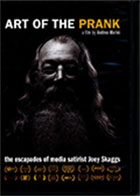
Art of the Prank 2015
Distributed by The Video Project, 145 - 9th St., Suite 102, San Francisco, CA 94103; 800-475-2638
Produced by Andrea Marini, Judy Drosd, Michele Malfetta
Directed by Andrea Marini
DVD, color, 85 min.
College - General Adult
Activism, Mass Media
Date Entered: 01/04/2018
Reviewed by Brian Falato, University of South Florida Tampa Campus LibraryThe term “fake news” is much tossed around today, sometimes applied to stories that are true but unflattering to an individual or organization. But Joey Skaggs has been responsible for generating news reports on genuinely fake events for over 40 years.
Skaggs grew up in the Laurel Hills section of New York, on the Brooklyn/Queens border. From a young age, he wanted to move to Manhattan and be an artist. He got accepted at the High School of Art and Design and graduated from there, expecting that he soon would be the next big thing on the gallery scene. But he found that a diploma from a prestigious school was not a guarantee of recognition in the art world. So, impatient for results, he decided to take a different tack with his art.
Protests over the Vietnam War were growing in the 1970s, and Skaggs thought he could add his artistic statement to the protests. He built a life-size Vietnamese village and nativity scene in a New York park and then had it destroyed. But instead of being seen as a powerful protest of what was happening in Vietnam, Skaggs’ only notice in the media came from the fact he was cited for littering in the park.
This provided an epiphany for Skaggs. As he says in Art of the Prank, “rather than just use the media to try to get attention for my work, I would use the media as part of my work.” And thus came a long line of pranks that caused a lot of embarrassment for media outlets that reported the events as actual news.
In 1976, Skaggs put a classified ad in the Village Voice for a “cat house for dogs.” The ad produced a lot of calls, and Skaggs developed a piece that ran on community access cable television in New York. This got the attention of WABC-TV, and they did an investigative piece on the cat house that actually won a local Emmy Award for Outstanding Feature News segment. Skaggs got further publicity from protests by the ASPCA and other animal rights groups, and was subpoenaed by the New York State Attorney General to testify about his activities. Skaggs was pleased that he was to appear on April Fool’s Day.
Keeping in mind that “a good hoax promises a good story and visuals,” Skaggs devised such stories as a priest offering confessions via a portable booth on a bicycle, a “fat squad” that would guard refrigerators from overweight people that tried to raid them, the extraction of fluid from giant cockroaches that promised to cure a host of diseases, and a machine that used artificial intelligence to determine the guilt or innocence of a criminal suspect, since verdicts by humans often drew outrage over the jury’s decision.
Skaggs is seen working on his latest prank, the implantation of shark stem cells in people so that they could constantly regrow teeth and never need a dentist. He produced a “documentary” on this that was screened at several film festivals and the Internet. A statement at the end of Art of the Prank says the veracity of the shark stem cell story had not been challenged, and that this documentary was the first time the story had been exposed as a hoax.
Skaggs’ work is a precursor to the Yes Men, and it’s mentioned that the Yes Men may not have existed if it weren’t for Skaggs’ activities. But the Yes Men’s fake news stories more often seem to have a serious political point that is being exposed with the fakery. Skaggs’ pranks are more a way just to get a good laugh at the expense of the gullible media. One has to salute him on his creativity in devising them, but with credibility of the media being at an all-time low and “fake news” becoming a potent political weapon, the frivolousness of his pranks has a disturbing element. But that’s something that would make for good discussion in sociology and mass media classes that use this video.